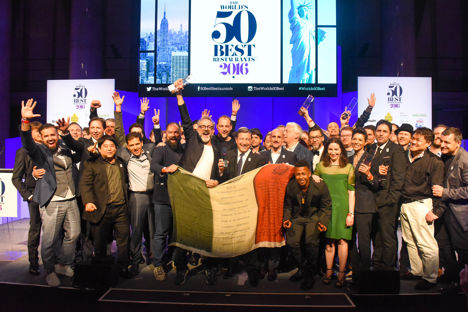
The World’s 50 Best Restaurants 2016
Italy takes the top spot; The Ledbury, The Clove Club and Dinner by Heston Blumenthal make the list, while a slew of Central and South American restaurants prove the continent is fast becoming a gastronomic paradise.
The World’s 50 Best Restaurants 2016
Italy takes the top spot; The Ledbury, The Clove Club and Dinner by Heston Blumenthal make the list, while a slew of Central and South American restaurants prove the continent is fast becoming a gastronomic paradise.
This year’s list of international culinary superstars has been released, with some exciting changes to the line-up. There’s a new number one, certain countries are making their mark and some new entries are shedding light on relatively unknown cuisines.
The UK’s highest entry was The Ledbury at 14, up six places from last year. Based in Notting Hill, the kitchen is led by Brett Graham, who opened the restaurant when he was just twenty-five and serves modern British dishes using the best of the UK’s produce.
The Clove Club entered the top fifty for the first time, coming in at 26, cementing head chef Isaac McHale’s position as a legendary chef. Now based in Shoreditch, the restaurant started life as a supper club and has grown in popularity thanks to its laidback, casual service. It also received The Highest New Entry Award, making it a London institution to keep an eye on.
Dinner by Heston Blumenthal rounded off the UK’s presence on the list at 45, proving the historical approach to British cuisine is still fascinating diners on the world stage. However, it’s a sharp drop from last year, when the Knightsbridge restaurant made the top ten at number seven.
Three more British restaurants placed in the 51–100 list, which was announced before the top fifty, all of which are based in London; Hedone in Chiswick (60), Lyle’s in Shoreditch (65) and St John in Farringdon (91).
Viva Italia
After two years of placing second on the list, Massimo Bottura’s Osteria Francescana in Modena, Italy has finally taken the top spot, earning the title of The World’s Best Restaurant 2016. Italian cuisine has enjoyed a surge of popularity here in the UK over the past twelve months, and this will only pique our interest in it further. Knocking famed Spanish restaurant El Cellar de Can Roca off the top spot (which now takes second place), Massimo’s playful, inventive plates that reinterpret dishes steeped in tradition won over the hearts and stomachs of the panel’s global judges.
Three of Massimo’s countrymen also made the top fifty – Enrico Crippa of Piazza Duomo (17), Massimiliano Alajmo of Le Calandre (39) and Davide Scabin of Combal Zero (46) were also present to prove that there’s much more to Italy’s food scene than cucina povera.
Latin flavour
There were eight Central or Southern American restaurants in the top fifty, compared with just three in France, suggesting a shift from western Europe into areas that just a decade ago were relatively unheard of. Central in Peru, owned by one of the world’s best chefs Virgilio Martinez (who also opened Lima in London, headed up by Robert Ortiz, if you fancy tasting the country’s incredible cuisine without hopping on a plane), placed fourth, beating the likes of previous winner Noma (fifth) and Mirazur in France (sixth). There were two other Peruvian restaurants – Maido (13) and Astrid y Gastón (30), proving that the country’s distinctive dishes and unique ingredients are finally getting the international attention they deserve.
Elsewhere, D.O.M in Brazil (11) and Boragó in Chile (36) bolstered South America’s culinary credentials, while Mexico made a surprising mark with three restaurants – Quintonil (12), Pujol (25) and Biko (43) – making the list. We expect this to kick-start a new appreciation for proper Mexican food that looks beyond the fajitas and burritos which currently dominate the country’s cuisine in the UK.
For the full list of restaurants, click here.
The World’s 50 Best Restaurants is decided by a group of twenty-seven panels from different regions around the world. Each panel has a chairperson, who chooses thirty-five members to cast a vote.
These members then cast up to seven votes for the best restaurants they have eaten at in the past eighteen months. Three of the votes must be for restaurants in their own region, with the rest from elsewhere in the world.
While the Michelin Guide has very specific criteria regarding who can receive awards, The World’s 50 Best Restaurants is based on the personal experiences of the voting panel. They cannot vote for their own restaurants or anywhere in which they have a vested interest, but apart from that the rules are quite lax. This means much more casual or offbeat restaurants can stand side-by-side with the more traditional dining rooms.


